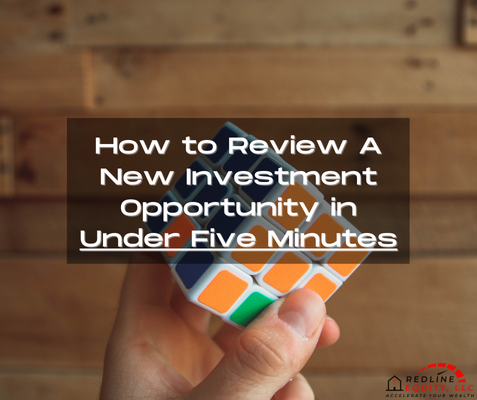
The First Glance
New deal alert emails are like a surprise gift. You had no idea it was coming, but you can’t wait to rip it open and see what’s inside.
You receive a deal alert and pull these details:
Asset Type: B-class multifamily
Market: Dallas, TX
Hold time: 3 - 5 years
Minimum investment: $50,000
Fund Deadline: 3 weeks from today
With this simple, at-a-glance information, you’re able to immediately see that although this is the perfect asset class and market you wanted, you are aiming for a longer hold or an emerging market. Or perhaps you already know you need more than 3 weeks to access your capital. PASS.
Another deal will pop up shortly and you’ll get opportunity after opportunity to practice this little exercise. At some point, the details will all be exactly what you’ve been waiting for and you’ll get to dig deeper.
The Numbers
Once you’ve decided a deal’s initial look aligns with your goals, it’s time to dig further into the investment summary and explore.
As an example, you might learn that this particular deal is offering:
8% preferred return
9% average cash-on-cash return
17% IRR
20% average annual return including sale
2.0x equity multiple
But what does all that mean for you and your $50,000?
In time, you’ll get lightning-quick at this and know right away what all of that means, but right now, let’s pretend this is your first go.
Preferred Return & Cash-on-Cash Return
Preferred return, a common structure for deals, means that the first percentage (in this case, 8%) of returns go 100% to the limited partner passive investors. Sponsors don’t receive any returns until the property earns more than that.
This means that if you invested 50K and everything went according to plan, you should see 8% of $50,000 or $4,000 this year, which breaks down to $333 per month.
Since cash-on-cash returns are projected at 9%, that tells you that this deal is projected to pay out above the 8% preferred return at some point.
Equity Multiple
The next fun number on the list is the equity multiple. This number quickly tells you how much your investment is expected to grow during the project.
Continuing on the example above, your $50,000 investment with a 2x equity multiple should work out to $100,000 once the asset is sold. This accounts for the cash flow distributions plus the profits from the sale.
We typically aim for a 1.75x - 2x equity multiple on deals, so you can use that as your benchmark.
Average Annual Return & IRR
My last two concerns when initially examining a new deal alert are the average annual return and the IRR.
The average annual return tells you what the average earnings are, averaged over the hold time.
In the example above, we discovered that your $50,000 is expected to double to $100,000 over the next 5 years. That total return is 100% of your original investment, and when divided over the 5 year hold period, we see that your average annual return is 20%.
The IRR (internal rate of return) is the average annual return (in this example 20%) and adjusts for the time delay. Since the majority of your earnings are expected later, at the sale, and time has cost associated with it, the IRR takes that into account. An IRR of 14% or more is a great target.
The Decision
After this 5 minute analysis of these data points, you should be able to tell if this deal is a potential yes or no for you. This isn’t a final decision and it doesn’t mean you’re putting in a wire transfer this afternoon, but it does mean you can decide to spend more time reading into the investment summary or not, and you can make that decision with confidence.
If these numbers align with your investing goals, you can go ahead and let the sponsor know you’re interested by requesting the full investment summary or submitting a soft reserve.
Conclusion
New investment deal opportunities can be exciting, but if you get lost in the weeds too quickly, they can become overwhelming too.
Whether you’ve had funds ready for weeks or are still in limbo getting them rolled over into a self-directed IRA, it’s imperative to know exactly what you’re looking for so you can jump on the perfect deal and minimize wasted time.
With the data points, you learned to look at in this post, you’ll be able to identify if a deal is even worth your time and energy right off the bat.
To learn more about real estate investing and syndications, join the Redline Equity Investor Club to see our upcoming opportunities.

Comments